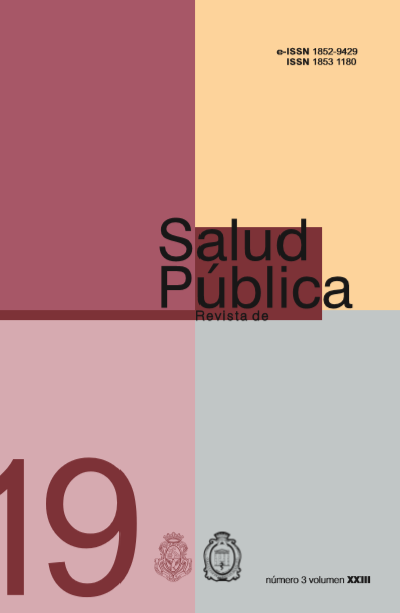ONSET AGE AND ALCOHOL INTAKE IN INJURED PATIENTS TREATED AT EMERGENCY ROOMS IN XAPALA, MEXICO
DOI:
https://doi.org/10.31052/1853.1180.v23.n3.23564Keywords:
alcohol, onset age, injuries, emergency roomAbstract
Objective: To identify the association between alcohol consumption onset age with consumption pattern and troublesome consumption in injured patients. Method: Cross sectional study in injured patients treated in emergency rooms in two public hospitals who reported alcohol consumption at least once in their lives. Variables: sex; onset age, alcohol consumption before the lesion, consumption pattern in the last year and troublesome consumption. Results: 354 patients were included; average alcohol consumption
onset age was 17±4. Significant differences were observed between onset age with: sex (p=0.006), alcohol consumption before the lesion (p=0.001) and troublesome consumption (p=0.001). Conclusion: In this study it was observed that younger consumption onset age was associated with more troublesome alcohol consumption and high and customary consumption pattern. It is necessary to establish specific intervention strategies to reduce alcohol intake at early ages.
Downloads
References
Organización Panamericana de la Salud (OPS). El alcohol: un producto de consumo no ordinario. Investigación y políticas públicas. 2010. Washington, D.C.: OPS.
Medina-Mora ME, Peña-Corona MP, Cravioto P,Villatoro J, Kuri P. Del tabaco al uso de otras drogas: ¿el uso temprano de tabaco aumenta la probabilidad de usar otras drogas? Salud Publica Mex 2002;44 supl 1:S109-S115.
Andreuccetti G, Cherpitel CJ. Una perspectiva histórica sobre el alcohol y las lesiones traumáticas, con base en estudios sobre los servicios de urgencias realizados en las Américas. En Cherpitel, C.J., Borges, G., Giesbrecht, N., Monteiro, M., y Stockwell, T. (Eds.), Prevención de los traumatismos relacionados con el alcohol en las Américas: de los datos probatorios a la acción política. 2013;43-51. Washington, D.C.: OPS.
Wilsnack RW, Vogeltanz ND, Wilsnack SC, Harris TR, Ahlström S, Bondy S, et al. Gender differences in alcohol consumption and adverse drinking consequences: cross cultural patterns. Addiction. 2000;95(2):251-65.
Jernigan DH. Global Status Report: Alcohol and Young People. Geneva: World Health Organization. 2001. [Internet]. Disponible en: http://www.who.int/iris/handle/10665/66795. Fecha de consulta: 29 de enero de 2019.
Pérez-Trujillo M, Reyes MF, Cabrera L, Pérez-Gómez A. Changing the beat: Fostering prevention of alcohol- related violence in night-time leisure zones. International Criminal Justice Review. 2016;26:169-186.
Gogeascoechea-Trejo MC, Méndez-Main SM, Natera-Rey G, Blázquez-Morales MSL, De San Jorge-Cárdenas X, Treviño-Siller S. Consumo de alcohol y lesiones: un estudio en población atendida en servicios de urgencias. Salud Mental. 2016;39(2):61-68.
Pérez-Gómez A, Lanziano C, Reyes-Rodríguez MF, Mejía-Trujillo J, Cardozo-Macías F. Perfiles asociados al consumo de alcohol en adolescentes colombianos. Acta colomb psicol. 2018;21(2):258-269.
Tapia CR, Medina-Mora ME, Cravioto QP. Epidemiología del consumo del alcohol. En Tapia (Ed.). Las adicciones: dimensión, impacto y perspectivas. 2001. México: Manual Moderno.
Korcha R, Cremonte M. Comparación de las características demográficas como factores predictivos del consumo de alcohol y de traumatismos por nivel de ingresos del país. En Cherpitel CJ, Borges G, Giesbrecht N, Monteiro M, y Stockwell T. (Eds.), Prevención de los traumatismos relacionados con el alcohol en las Américas: de los datos probatorios a la acción política. 2013;109-118. Washington, D.C.: OPS.
World Health Organization. Global status report on alcohol and health. 2014. Ginebra: OMS.
Espada SJP, Méndez CFX, Hidalgo MMD. Consumo de alcohol en escolares: descenso de la edad de inicio y cambios en los patrones de ingesta. Adicciones. 2000;12(1):57-64.
Sánchez CIA, Roa SV, Gómez AC, Rodríguez-Orozco AR. Prevalencia de consumo riesgoso de alcohol en adolescentes de una escuela preuniversitaria urbana de Morelia. Rev Cubana Pediatr. 2008;80(4). [Internet]. Disponible en: http://scielo.sld.cu/scielo.php?script=sci_arttext&pid=S0034-75312008000400005 Fecha de consulta: 21 de enero de 2019.
Hernández LT, Roldán FJ, Jiménez FA, Mora RC, Sánchez-Garnica D, Pérez AMT. La Edad de Inicio en el Consumo de Drogas, un Indicador de Consumo Problemático. Psychosocial Intervention. 2009;18(3):199-212. [Internet]. Disponible en: http://scielo.isciii.es/scielo.php?script=sci_arttext&pid=S1132-05592009000300002&lng=es&tlng=es Fecha de consulta: 21 de enero de 2019.
Villatoro VJA, Mendoza MMA, Moreno ML, Oliva RN, Fregoso ID, Bustos GM, Fleiz BC, Mujica SR, López BMA, Medina-Mora IME. Tendencias del uso de drogas en la ciudad de México: Encuesta de estudiantes, octubre 2012. Salud Mental. 2014;37:423-435.
Zúñiga BA, Bouzas RA. Consumo de alcohol en los adolescentes: percepción de consecuencias positivas y negativas. Revista Mexicana de Psicología. 2006;23(1):97-110.
Oliva RNN, Barcellos DMC, Alonso CMM, López GKS. Accidentes y lesiones por consumo de alcohol y drogas en pacientes atendidos en una sala de urgencia. Rev. Latino-Am. Enfermagem. 2010;18(Spec):521-8.
Guerrero-López CM, Muños-Hernández JA, Sáenz de Miera-Juárez B, Pérez-Núñez R, Reynales-Shigematsu LM. Impacto del consumo nocivo de alcohol en accidentes y enfermedades crónicas en México. Salud Publica Mex. 2013:55(supl 2):S282-S288.
Pautassi RM. Consumo de alcohol durante la adolescencia y el desarrollo temprano, causas y consecuencias. Ciencia e investigación. 2013;63(4):25-38.
Borges G, Cherpitel CJ, Orozco R, Bond J, et al. Multicentre study of acute alcohol use and non-fatal injuries: data from the WHO collaborative study on alcohol and injuries. Bull World Health Org. 2006;84:453–460.
Vicente HMT, Ruiz-Flores BM, Bozzini D, Capdevila GL, Ramírez IMV, Terradillos GMJ, López GAA. Consumo de alcohol y riesgo de accidentes de tráfico en España. Aspectos preventivos. Medicina Balear. 2014;29(3):18-24.
Downloads
Published
Issue
Section
License
Copyright (c) 2019 Escuela de Salud Pública y Ambiente. Facultad de Ciencias Médicas. Universidad Nacional de Córdoba

This work is licensed under a Creative Commons Attribution-NonCommercial 4.0 International License.
Authors who publish with this journal agree to the following terms:
- Authors retain copyright and grant the journal right of first publication with the work simultaneously licensed under a Creative Commons Attribution License which allows the work to be copied, distributed, exhibited and interpreted as long as it is not done for commercial purposes.
- Authors are able to enter into separate, additional contractual arrangements for the non-exclusive distribution of the journal's published version of the work (e.g., post it to an institutional repository or publish it in a book), with an acknowledgement of its initial publication in this journal.
- Authors are permitted and encouraged to post their work online (e.g., in institutional repositories or on their website) after the publication process. (See The Effect of Open Access). (See The Effect of Open Access).







